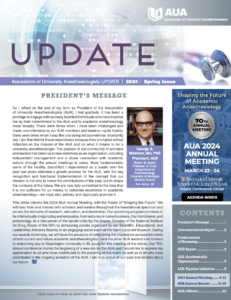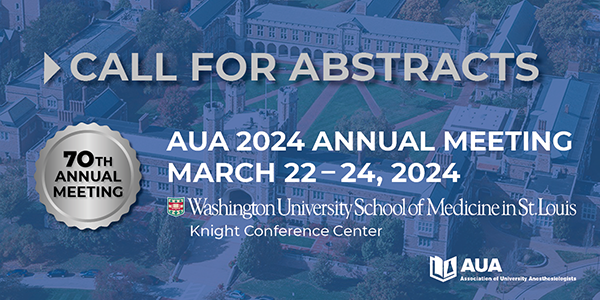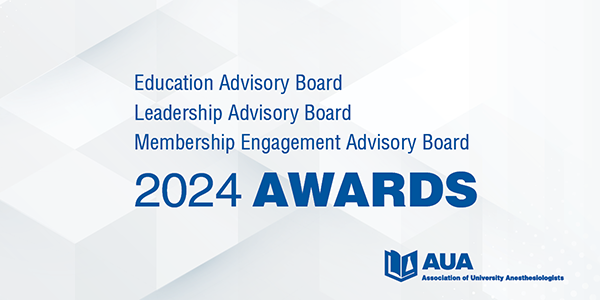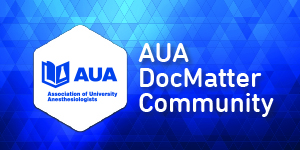Redefining the Role of the AUA in Academic Anesthesiology
The mission of the Association of University Anesthesiologists (AUA) is “to promote excellence in academic anesthesiology through mentorship; promotion of diversity and inclusivity; and professional growth throughout the careers of educators, academic leaders, and researchers.” This mission, with a focus on the promotion of excellence in academic anesthesiology, might seem inconsistent with the common or historical perception of the AUA as an honorific society that merely recognizes excellence. The AUA is, however, thoughtfully transitioning to a more functional organization with the goal of actively expanding, advancing, and diversifying academic anesthesiology. This evolution might create discomfort for some, or even concern. As I consider the AUA and the state of academic anesthesiology, here are some reflections as to why this strategic refocusing is imperative.
- Academic anesthesiology is under threat. Economic and operational pressures, coupled with a relative lack of resources, have the potential to compromise the academic mission of anesthesiology as well as many other medical specialties. The traditional tripartite mission and co-equal status of clinical care, research, and education in the academic medical center can no longer be assumed. As such, the AUA cannot fully serve the field by only recognizing excellence—we must actively cultivate it.
- We need diverse teams to ensure a vibrant future for academic anesthesiology. Academic anesthesiology faces new threats, but it also has new and exciting opportunities. Diversity of perspective is an important way to foster creative solutions that can mitigate threats and actualize opportunities. The AUA must broaden the conception and recognition of individual accomplishments through a growth mindset that attracts committed academic anesthesiologists with diverse backgrounds and skills.
- A pivot from exclusivity does not mean a pivot from excellence. We must reject the artificial dichotomy of inclusivity vs. quality. Thoughtfully broadening the membership criteria of the AUA will be critical to building a stronger academic workforce that can advance the field in a multidimensional way. We cannot afford to leave any talent untouched or underdeveloped—the AUA should not just be a place where the giants roam but also a place where the giants grow. The AUA can be elite in its contributions without being elitist.
- We need to democratize scientific excellence and increase accessibility. Academic anesthesiology is a complex network and there is increasing evidence of the network phenomenon of “preferential attachment”—commonly embodied in the phrase “the rich get richer.” As funding and talent become more concentrated in a limited number of departments or institutions, the fabric of academic anesthesiology can weaken and a cultural divide can widen. Promoting engagement in data-sharing or research networks creates the possibility of democratizing scientific contributions. The AUA is committed to broader reach and inclusion of university anesthesiology departments to share best practices, mentorship, and support.
- We need to partner with organizations in our field and likeminded organizations in other fields. Academic anesthesiology has several organizations with unique strengths and foci. The AUA is committed to partnering thoughtfully and strategically to reduce duplication or competition and to enhance synergy. Furthermore, we need to partner with other academic organizations across diverse fields to understand best practices in promoting academic culture in a healthcare environment of increasing constraints. The AUA can be a vital partner in a team-based approach to advancing academic anesthesiology.
Fortunately, we have a plan. A task force—led by Jeff Kirsch, Dolores Njoku, Monica Vavilala, Keith Vogt, and Jeanine Wiener-Kronish, with the strong support of Vivian Abalama—worked intensely throughout 2021 to develop strategic direction. The entire AUA council—including the new chair of the Scientific Advisory Board, David Mintz, and the new chair of the Educational Advisory Board, Susan Martinelli—have been engaged in refining this plan. There is high enthusiasm as we begin implementation in 2022. Working together with a broad AUA membership that is collectively committed to excellence in the field, we are confident that we can achieve our ambitious goals to help secure and shape the future of academic anesthesiology.
Read Dr. Mashour’s article, “Redefining the Role of AUA in Academic Anesthesiology,” in ASA Monitor (Volume 86, Issue 4 | April 2022). Visit: https://buff.ly/3NLQKg3











